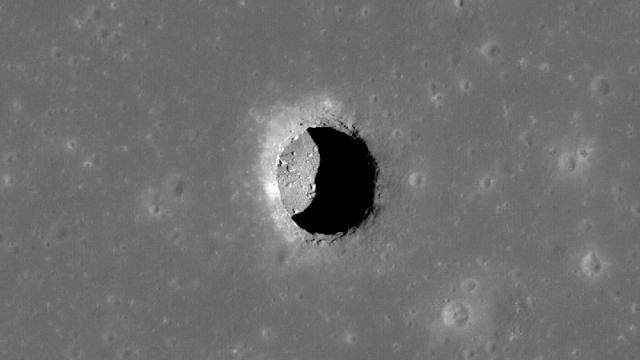Data from a NASA probe suggests lunar pits have comfortable temperatures due to their shadowy overhangs, which keep them cool during the day and prevent heat from escaping at night.
Hard to believe now, but the seemingly inert surface of the Moon was once rife with volcanic activity. Today, we see evidence of this in the form of pits that litter the lunar surface. We’ve been privy to these pits for nearly 15 years, but recent research indicates that the temperatures within them could be far cooler — and arguably more comfortable — than the surrounding surface.
Data gathered by NASA’s Lunar Reconnaissance Orbiter place the interior of the pits at a relatively consistent 63 degrees Fahrenheit (17.2 degrees Celsius) throughout the lunar day/night cycle. If confirmed, this would make them ripe targets for exploration and human habitation.
“Lunar pits are a fascinating feature on the lunar surface,” said Noah Petro in a NASA press release yesterday. Petro is an LRO project scientist based at NASA’s Goddard Space Flight Centre in Greenbelt, Maryland. “Knowing that they create a stable thermal environment helps us paint a picture of these unique lunar features and the prospect of one day exploring them.”
These findings were published earlier this month in Geophysical Research Letters by scientists from the University of California in Los Angeles and the University of Colorado, Boulder. “About 16 of the more than 200 pits are probably collapsed lava tubes,” said project leader Tyler Horvath in the NASA press release. The researchers noticed that some of the pits have overhangs — the key feature that could offer future Moon explorers protection from incoming cosmic rays, micrometeorites, and wild fluctuations in surface temperature.
According to NASA, the surface of the Moon can reach highs of 260 degrees Fahrenheit (126.7 degrees Celsius) and lows of -280 degrees Fahrenheit (-173.3 degrees Celsius). But these overhangs, it appears, shade the pits during the day while preventing heat from escaping at night, leading to a consistently balmy temperature around 63 degrees Fahrenheit (17.2 degrees Celsius).
As NASA’s efforts to return humans to the Moon ramp up, creative approaches to long-term stays on the lunar surface are gaining in importance. While it’s not clear exactly how (of even if) NASA will work these pits into their mission plans, the opportunity to rely on their stable temperatures presents an intriguing possibility.
More: What to Know About Lunar Gateway, NASA’s Future Moon-Orbiting Space Station
